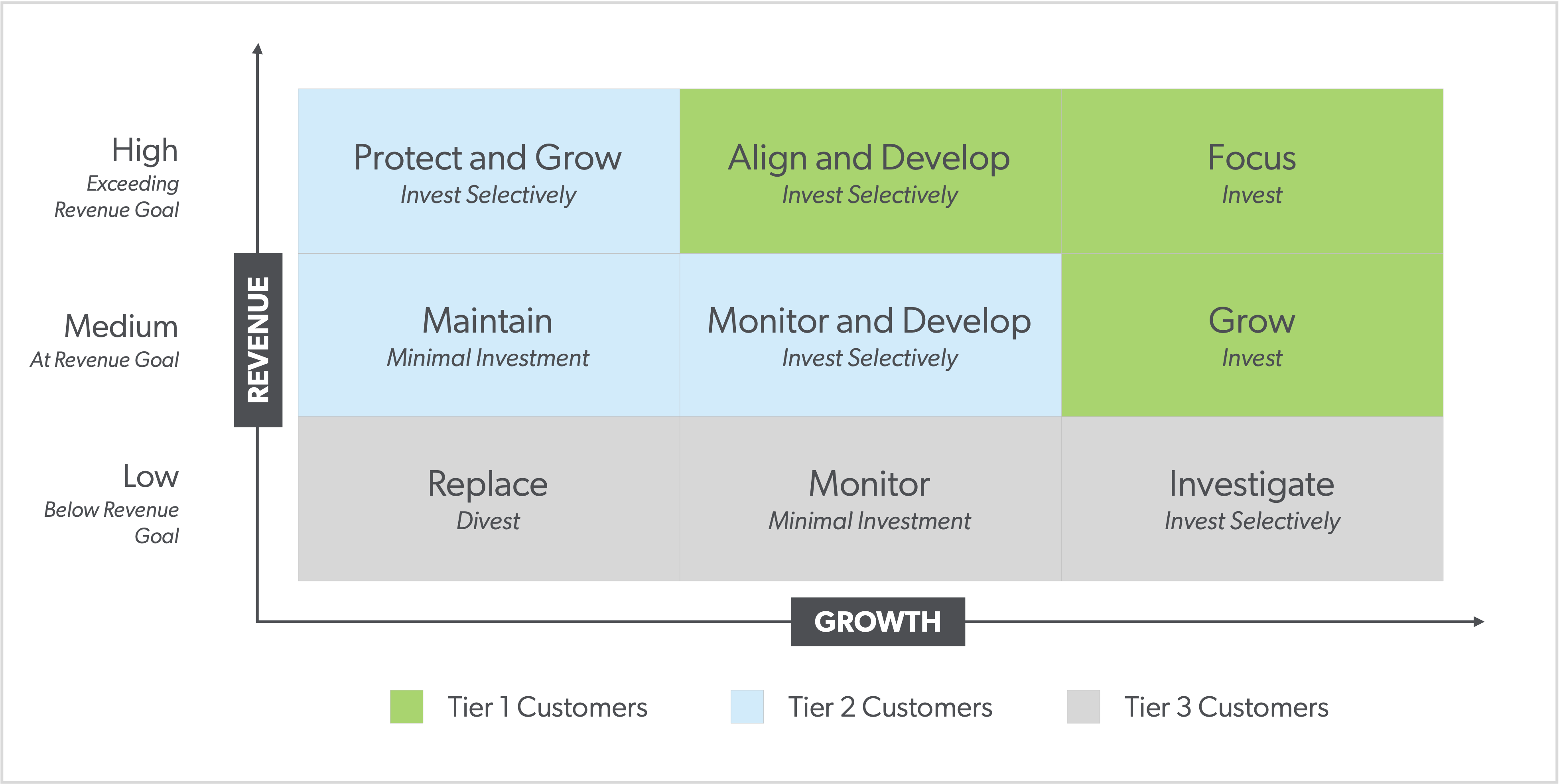How to Spin Long-Tail Customers into Gold
In this series, we’re exploring the untapped potential long-tail customers offer B2B sales organizations. Part 1 exposes why long-tail customers, or those who spend below a certain revenue threshold, are hidden gems of revenue, expansion, and retention.
Innovating your B2B sales engine to unearth new growth and serve customers who are looking for a reason to keep buying from you is not just wise—it’s essential. If you see the vision, you’re ready to find the approach that’s right for you. With the right strategy, managing your long-tail customers can not only juice your revenue stream but help you grow.
In this blog, we’ll surface proven methods for reconnecting with your long-tail customers, harnessing their energy, and tapping into the free-flowing revenue vein they can be.
Define Your Long-Tail Customer Goals
Your long-tail customers hold a lot of promise. But before you deploy a single resource to serve them, you must identify your goals. Is customer retention more important to you? Do you need to ensure those customers don’t abandon you, so you don’t lose 20% of your revenue? Does your long-tail customer strategy need to prioritize holding on to those customers?
Do you want to focus on expanding their spend with you? If your long-tail customers are only giving you a small percentage of their total share of wallet, there may be more value in the 20% of the revenue they’re contributing.
Whatever your goal, there is gold in your long-tail customers.
Flip the B2B Sales Script
Per McKinsey & Co., underperforming B2B sales teams spend a disproportionate amount of their time—more than 50 percent in some cases—serving customers that contribute 20% or less to the company’s revenues.
Long-tail customers matter, but you need to strike a balance between efficiently meeting their needs and optimizing their spend with you. Applying resources to them reactively will erode your revenue upside. And visiting them randomly won’t move the needle, because they won’t get the attention they need to stick around, let alone grow. And while conserving resources is important on a good day, it’s crucial in times of economic uncertainty.
Start with flipping the equation. It’s what top sales teams do, says McKinsey. They invest in advanced technology stacks, data and analytics, and prescriptive insights and ensure that the most intensive sales engagement is preserved for high-value accounts—lowering cost-to-serve by an average of 10 to 20 percent and increasing revenue per sales FTE by an average of 3 – 15 percent.
“[Top sales teams] prioritize accounts by spend and growth potential, enriching their in-house analyses with third-party data to refine segmentation and define next-best-action opportunities.”
Source: McKinsey & Company
Focus Mercilessly on the Most Valuable Opportunities
Some revenue leaders throw additional headcount at their long-tail customers, but this isn’t the most efficient or effective use of resources. Even if you have a successful model for serving your biggest customers, doing the same for your smaller customers at scale is a big challenge.
The key to mining for long-tail customer gold long term is identifying the most valuable opportunities—and then focusing on them mercilessly. With analyses and segmentation, you can identify those customers among those who make up the 20% in revenue that are the most valuable so you can focus your energies and resources in the right ways.
For example, you know you’re not getting a particular customer’s entire share of wallet. You need to understand where the other portion is going and how to get it. Or maybe you want to uncover how you can expand their overall spend with you.
The first stop on that journey? Data.
Long-Tail Customer Data is Gold
Data is critical to all your needs, both for strategic planning and to inform your decisions. This includes AI (if you rely on it), which needs data to work. And it’s essential to get the proof points you need to identify your growth opportunities.
Before unleashing a single sales resource, assess each account’s potential, prioritize those with the highest potential, and apply your sales resources and talent accordingly. Use your internal and third-party data and power metrics to identify and score your high-growth potential tail accounts.
How MarketSource Does It:
Using Esri™, the world’s most powerful mapping and spatial analytics software, our team of data scientists, geospatial experts, and geographic information system (GIS) analysts examine all data relevant to our client’s market to uncover hidden patterns, pinpoint competitive opportunities, and identify customers with the highest growth potential
Here’s a framework we use once we’ve scored and segmented long tail customers based on revenue opportunity and growth potential. This allows us to visualize each customer’s relative value and our recommended actions for each.

How Can I Reach My Long-Tail Customers?
Once you plot your customers’ growth and revenue potential, you can see where you need to apply the right resources at the right time—designed to achieve your specific goals for each customer.
McKinsey suggests embracing a remote-first model for long-tail customers. For example, you may want to assign your low-growth, or Tier 3, customers to remote engagement with your inside sales team and self-service digital sales channels. To make this concrete, commit to moving 25% of your low-growth customers—those likely to contribute less than 10 percent in annual revenues—to inside and digital sales channels within a year.
This will involve more of a one-to-many approach, but it’s a more relevant, efficient, and cost-effective way to serve this segment and is in line with the return you are likely to get from these accounts.
And you may want to shift your engagement with high-value, or Tier 1, accounts from reactive and manual to proactive and automated. You can still maintain a one-to-one or one-to-few approach with these accounts, but by automating them, adhering to a prescriptive cadence, and adding personalization, you can ensure consistent, high-quality touches that engage those customers in ways that matter to them.
It may be worth investing in technology to realize these changes. With tech enablement, the ratio of long tail customers you can serve will increase. Note that enabling technology and digital customer touches does introduce process development time constraints. Depending on your goals and timeline, an outsourced managed sales partner can help by accelerating the ROI of your long-tail customer coverage.
McKinsey also recommends establishing a weekly steering cadence to align sales team activities with high-value opportunities and ruthlessly de-prioritize lower-value engagement.
Why Consider Outsourcing Your Long-Tail Customer Management?
Even if you recognize the growth potential of your long-tail customers, you may not have the capabilities or resources in-house to serve them in a sustainable way that both maximizes their revenue contribution and your resources. Gearing up a team to tackle your long-tail customers could take months, potentially costing you lost revenue from churned accounts during that time.
If you’re not sure where to start, or the task seems overwhelming, outsourcing might be worth a look. Outsourcing the management of these accounts can accelerate the ROI of your long-tail customer coverage and allow you to focus on the other areas of your business.
In times such as these, mining your long-tail customers for gold isn’t just wise—it’s essential. And while prioritizing the 20% of your customers who make up 80% of your revenue is understandable, neglecting the 80% of your customers who make up the remaining 20%, no matter their size, is not just a missed opportunity—it’s a mistake.
Ready to talk?

Author: Ben Simms
Ben is Executive Director of Commercial Client Services for MarketSource. He leads a portfolio of client engagements and teams to execute a wide range of B2B sales and marketing solutions across several verticals and industries. Ben deploys and manages inside sales, outside sales, sales training, and brand ambassador teams representing Fortune 500 companies.
Want More Sales?
Subscribe now to receive occasional emails with insights that help you accelerate profitable growth, risk reduction, market expansion, and revenue velocity.
What are you waiting for?

